Hervé Renard’s Saudi Arabia have been one of the most exciting teams at this year’s FIFA World Cup; the underdogs have punched above their weight and held their own in both group-stage games so far. In their tournament opener, they managed to claim the scalp of Lionel Messi’s Argentina — making progression through the group stage far from a foregone conclusion for La Albiceleste. In their second game, though they ultimately lost to Poland, they delivered a rousing performance from which they arguably deserved more.
Saudi Arabia came into this tournament as the second-lowest ranked side in the competition; They sit in 51st place in the world according to the FIFA World Rankings. However, you would never guess that from their fearless performances so far. Renard has played with a lot of hunger, bravery and tactical intelligence in their opening two games — if they can take the same approach into their third and final group stage fixture versus Mexico, there’s no reason why they can’t get out of this group.
This tactical analysis piece isn’t about that upcoming Mexico game on Wednesday, though. This will be a post-match analysis dissecting the tactics deployed by both Saudi Arabia and Poland in yesterday’s 2-0 win for Biało-czerwoni.
This game threw up a tonne of tactical talking points all of which we could provide a deep dive into. We’re going to hone in on Saudi Arabia’s tactics, in and out of possession, and how the ball-dominant side, who ended the game with 64.9% of the possession, caused Poland so much trouble despite the European side coming away with three points in the end.
Lineups
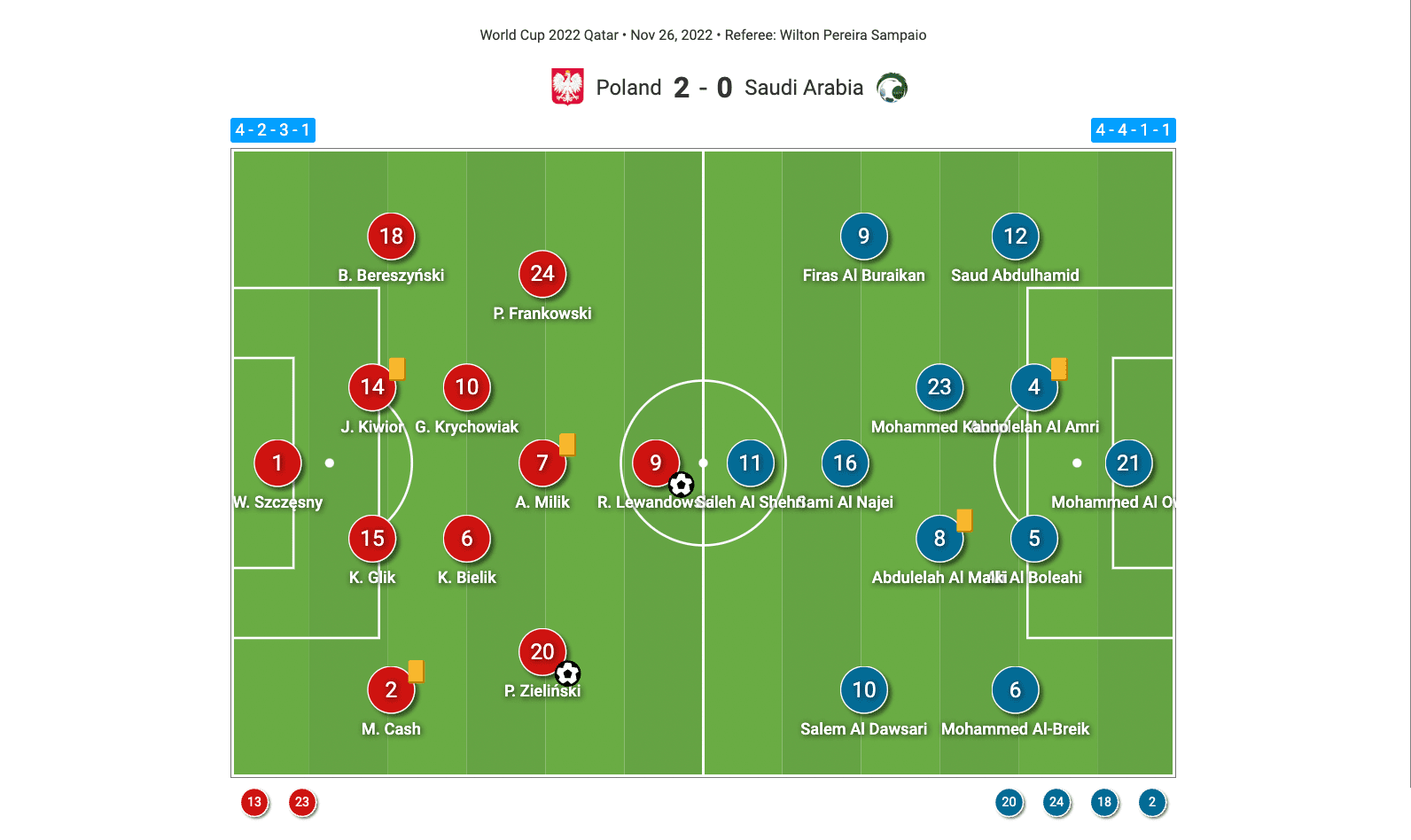
Firstly, we’ll discuss the lineups used by both teams in this game. Starting with the eventual winners Poland, Czesław Michniewicz set his team up in a 4-4-1-1 shape which saw Wojciech Szczęsny start in goal behind a back four of right-back Matty Cash, right centre-back Kamil Glik, left centre-back Jakub Kiwior and left-back Bartosz Bereszyński.
The first goalscorer, Piotr Zieliński of Serie A side Napoli, started on the right wing with Krystian Bielik and Grzegorz Krychowiak playing centrally, between Zieliński and left-winger Przemysław Frankowski. Up front, Arkadiusz Milik played just off of former Bayern Munich and current Barcelona star Robert Lewandowski, who scored Poland’s second goal of the game.
Michniewicz made just two changes to that starting XI over the course of the game, the first of which saw Jakub Kamiński replace goalscorer Zieliński after 63 minutes and Krzysztof Piątek come on for Milik in the 71st minute.
As for Saudi Arabia, Renard also lined his team up in a 4-4-1-1 shape. Mohammed Alowais started in goal for Saudi Arabia, behind a back four consisting of right-back Saud Abdulhamid, right centre-back Abdulelah Ali Awadh Al Amri, left centre-back Ali Albulayhi and left-back Mohammed Alburayk.
Feras Albrikan started on the right of midfield, with Mohamed Kanno and Abdulelah Almalki in central midfield and Salem Al Dawsari on the left wing. Ahead of them, Sami Al-Najei played just behind Saleh Al Shehri up front.
Meanwhile, Renard made four changes to his lineup during this contest. Their first substitution was Nawaf Alabid on for Al-Najei at half-time. Alabid wouldn’t ultimately last the entirety of the game, as he was subbed off himself due to injury just before the final whistle blew with Hattan Behebri taking his place to see out the game.
In between those two substitutions, Saudi Arabia introduced Abdulrahman Alobud for Almalki and Nasser Al Dawsari for Al Shehri in the 85th minute.
Saudi Arabia’s Ball progression
We’ll kick off our analysis by looking at Saudi Arabia’s ball progression and some specific ideas they employed to great effect against Poland. Constant off-the-ball movement and positional rotations were crucial to Saudi Arabia’s ball progression. They did well to manipulate Poland’s defensive shape, pulling players about and overloading key areas via their off-the-ball movement ahead of the deep ball carriers.
This movement wasn’t chaotic or random; it was very deliberate. However, it was complex and varied enough that it kept the Polish defence guessing and generally unable to fully cope with the Saudi players finding space in good positions. This allowed Renard’s side to slice through Poland’s defensive shape time and time again.
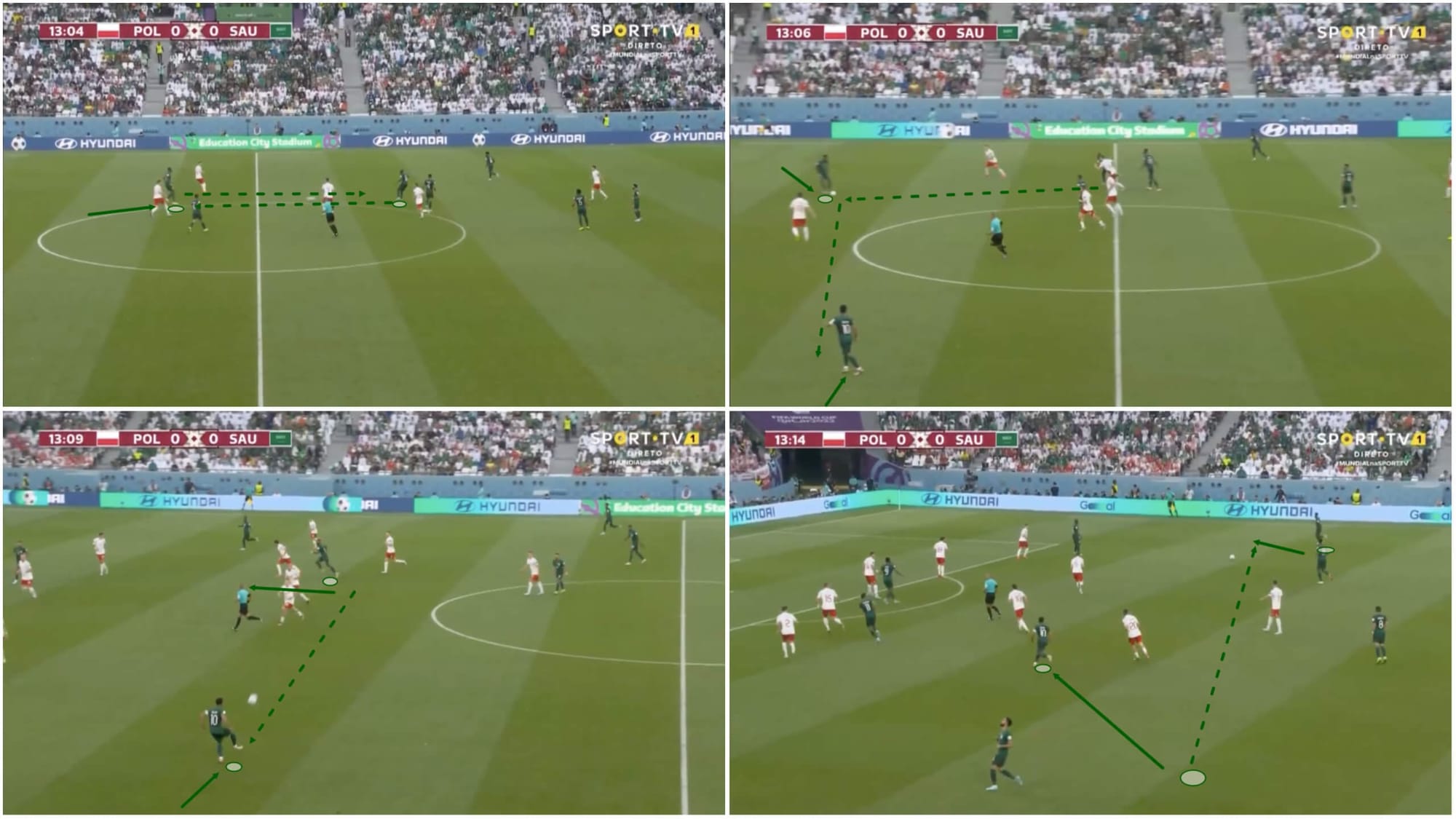
Figure 2 shows an example of Saudi Arabia creating options between the lines in central positions via quick passing exchanges and simultaneous intelligent off-the-ball movement. Here, the initial forward pass in the top-left quadrant is received with a heavy touch that leads to the ball just getting sent back to the original ball carrier. However, that player is able to progress the ball forward once more as Saudi Arabia’s right-winger, Albrikan, has come inside and found space behind the midfield line to give his teammate another option.
The right-winger receives between the lines and plays the ball out to left-winger Al Dawsari, who ends up taking the ball well before switching to an overlapping teammate on the opposite wing.
A lot is going on even in just this passage of play. But even regardless of how they end up progressing into the final third, for now, the key thing to note is the off-the-ball movement and quick passing exchanges that were a constant feature of the Saudi attacks versus Poland, and how they helped Saudi Arabia to carve through their opponents.
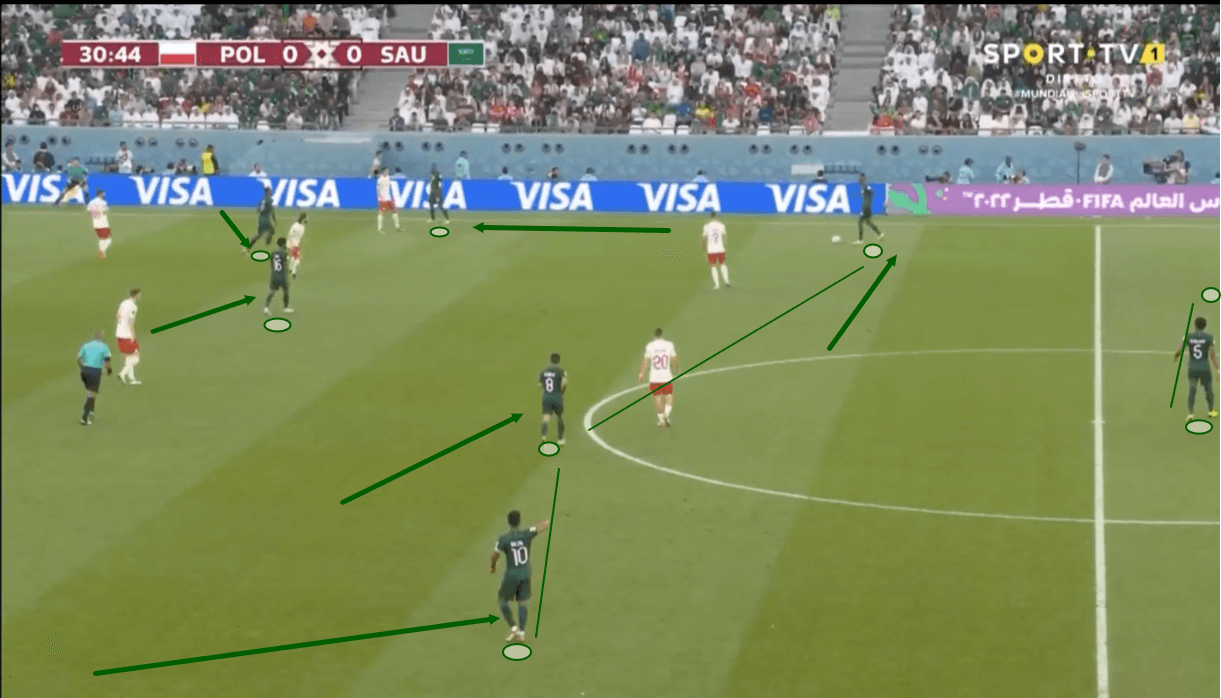
It was common to see the wingers, in particular, moving in centrally where they could end up in a lot of space with the corresponding full-back often occupied with an overlapping full-back from the other team and/or unwilling to follow the winger so far inside. We see an example of this in figure 3, where Saudi Arabia’s left-winger has come into a central position alongside his team’s double-pivot at the same time as his team’s left-back has run forward on the outside, keeping the Poland right-back busy.
Kanno has shifted out to the right to escape the Polish forwards’ cover shadows, and as he receives the ball, he draws the Poland defensive shape out to that wing. At the same time, his midfield partner Almalki has shifted over to a more central position, dragging right-winger Zieliński into him. This leaves lots of space for Al Dawsari to occupy on the left side of the 2-3 build-up shape Al-Saqour end up creating. As play moves on, we see Kanno switch the play to Al Dawsari on the left side of midfield.
Saudi Arabia’s attackers created another decent option via off-the-ball movement here as well, though, as the now-advanced right-back allowed the right-winger to come inside while, at the same time, Al-Najei dropped off into the right half-space too. This overloaded Poland in quite an appealing area, creating the potential for Saudi Arabia to progress through here if desired.
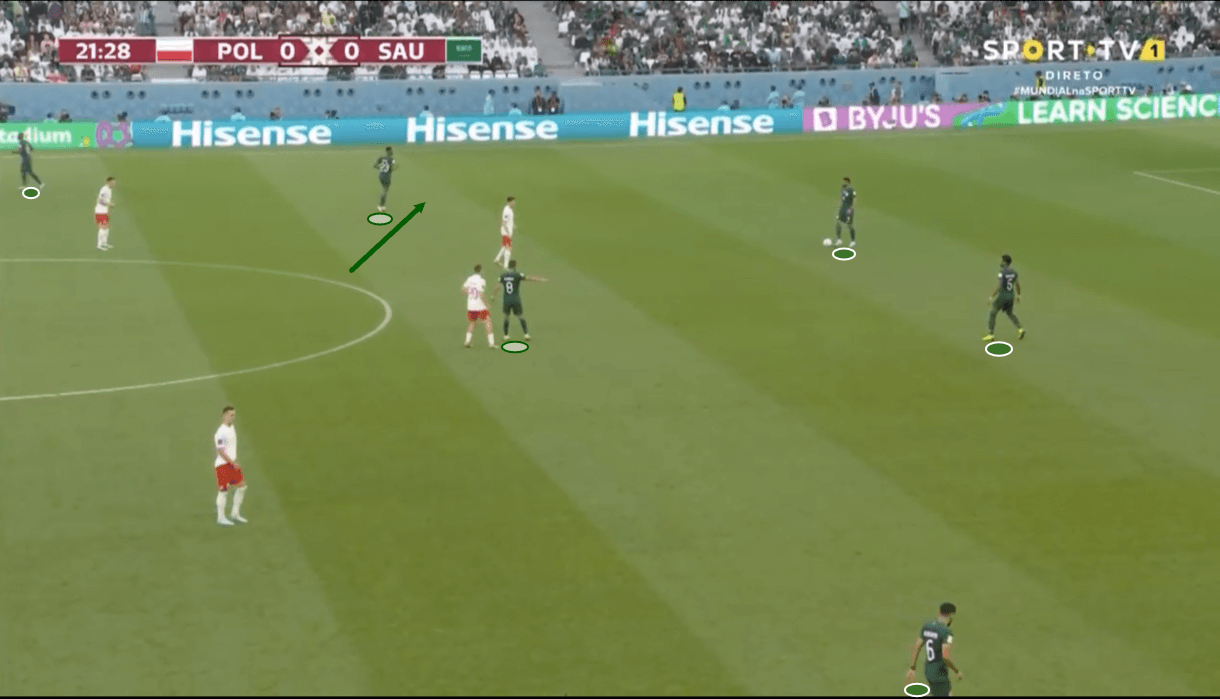
A lot of Saudi Arabia’s movement into the middle third of the pitch came through Kanno. Al Amri-Kanno (18) and Abdulhamid-Kanno (19) were two of the most frequent player passing links that Saudi Arabia had during this game. With Poland set up in a 4-4-2 designed to cage the midfield and prevent easy passes into the midfield, Kanno sometimes had to shift out to wider positions to get on the ball, as we saw in figure 3 and see again in figures 4-5 (midfielders with green exterior and white interior circles, defenders with white exterior and green interior circles).

Renard was happy to see Kanno on the ball in these positions as he was happy to see him on the ball in central positions. Kanno’s long passing is a notable strength in his game and this was utilised to great effect when he got on the ball in space where we see him in figure 5 with very little pressure on him, as was often the case in this game when he did shift out into these wider areas.
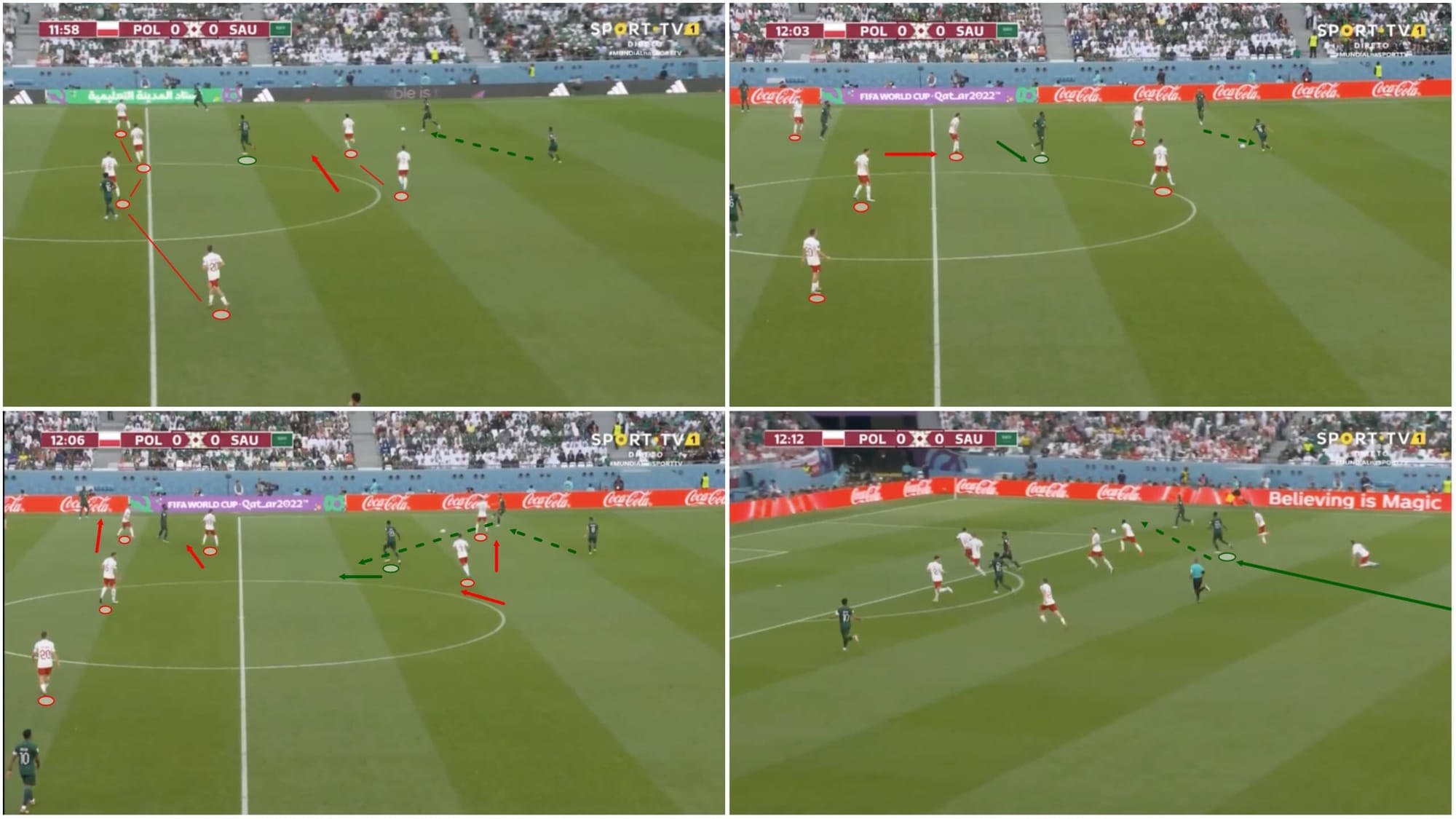
Long passing isn’t the only useful instrument in Kanno’s toolbox, however, as he was just as capable of finding space and receiving centrally, taking the ball on the half-turn and either penetrating the opposition via an accurate drilled ground pass forward or carrying the ball forward himself into a more dangerous position, as we see in figure 6.
Again, off-the-ball movement to manipulate the opposition’s shape was just as crucial to the progress as Kanno’s technical quality was in this instance. The top right quadrant shows that Poland’s right central midfielder closed the Saudi midfielder down from behind, giving him no space to turn and putting the Saudi centre-back off playing to him at that moment.
However, moving on into the bottom-left quadrant, after Saudi Arabia shifted the ball over to the right centre-back again, that Polish midfielder was drawn over to the wing, away from Kanno, to help his left-winger guard against the overload from Saudi Arabia’s advanced right-back and right-winger. This left space for Kanno to receive and turn. This wasn’t luck or chance, it was evident that Saudi Arabia had prepared well to manipulate Poland’s defensive shape and positioning, and did a very good job of implementing those tactics on Saturday.
Saudi Arabia’s chance creation
You’ll notice from figures 2 and 6 in the previous section that both attacks ended up moving out to the wing as Saudi Arabia entered the final third. Similarly, in figures 4-5, the long ball from Kanno was switched all the way out to the opposite wing as Al-Saqour entered the final third too. It was another notable tactic from Saudi Arabia in this game to try and progress through the centre in the middle third and pull the opposition in tight there in order to create space for one of their wingers to exploit out on the wing, either in free space or in a 1v1. This occurred frequently on both wings but especially on the left, where Saudi frequently found Al Dawsari and set the tricky dribbler up to take on opposition defenders.
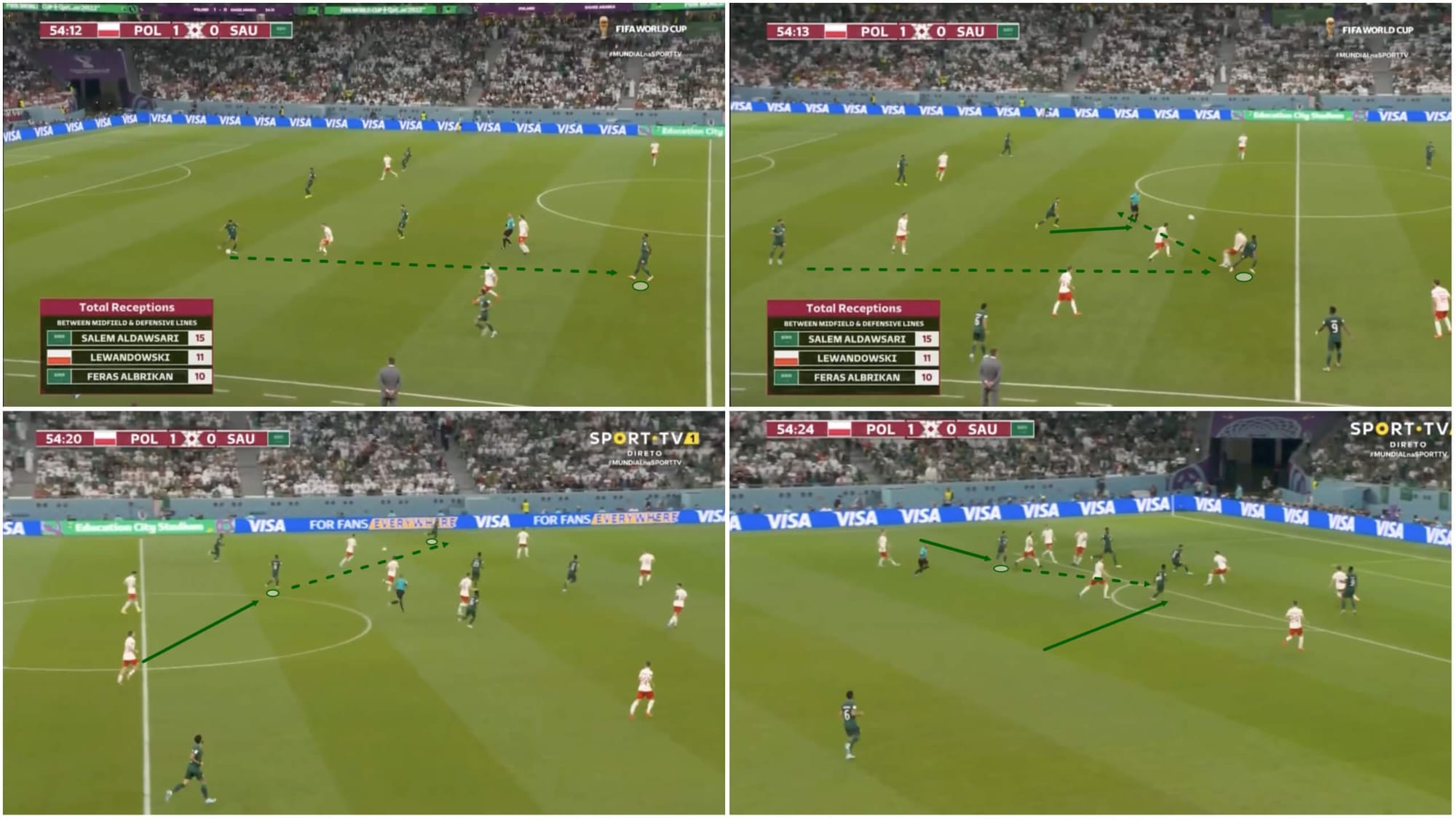
We see another example, resembling those we saw in the previous section, in figure 7, where Saudi Arabia found Kanno in space behind the midfield line, the midfielder acted as the third man here as he then played the ball inside to his midfield partner into whom the passing lane was blocked from the centre-back previously, before that player carried the ball forward and played it out to the left winger.
The winger was then able to carry the ball inside, get past a defender and slide the ball into a teammate’s path as they made a late run attacking the box to try and get a shot off from a decent location. This was a common pattern we saw in Saudi Arabia’s game on Saturday and was a deliberate way Renard set his team up to expose the Polish defence and goal.
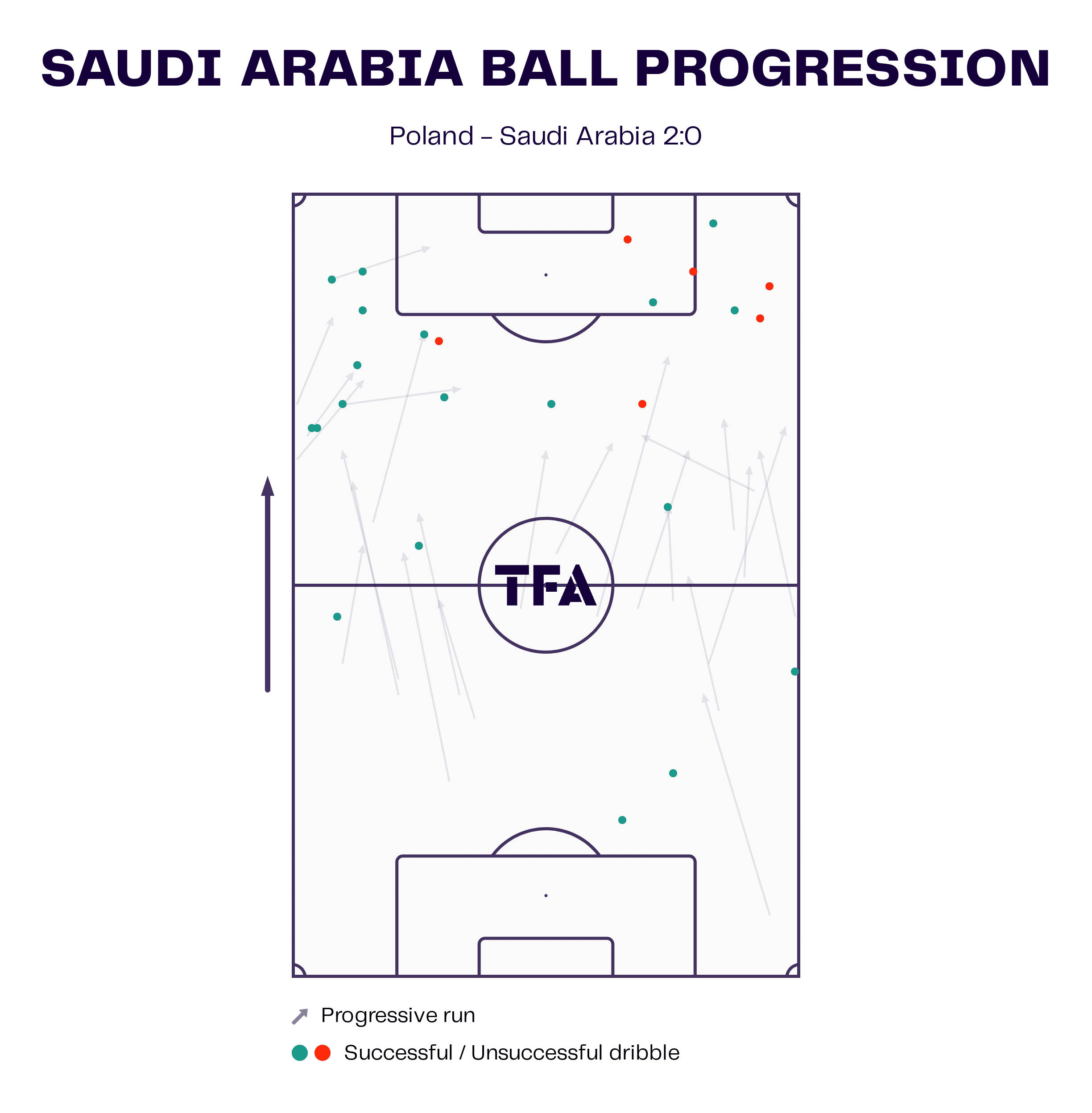
By the end of the contest, ball-dominant Saudi Arabia had created a lot of these favourable 1v1 dribbling scenarios, especially on the left wing — hence why we see so many green dots on the left wing in figure 8. While Renard’s side loved penetrating through the centre in the ball progression phase, they equally loved attacking the box via the wingers once they entered the final third; these players, especially Al Dawsari, indeed, brought electricity to the pitch when they got involved and it’s not surprising that Al-Saqour tried to get them involved as much as possible.
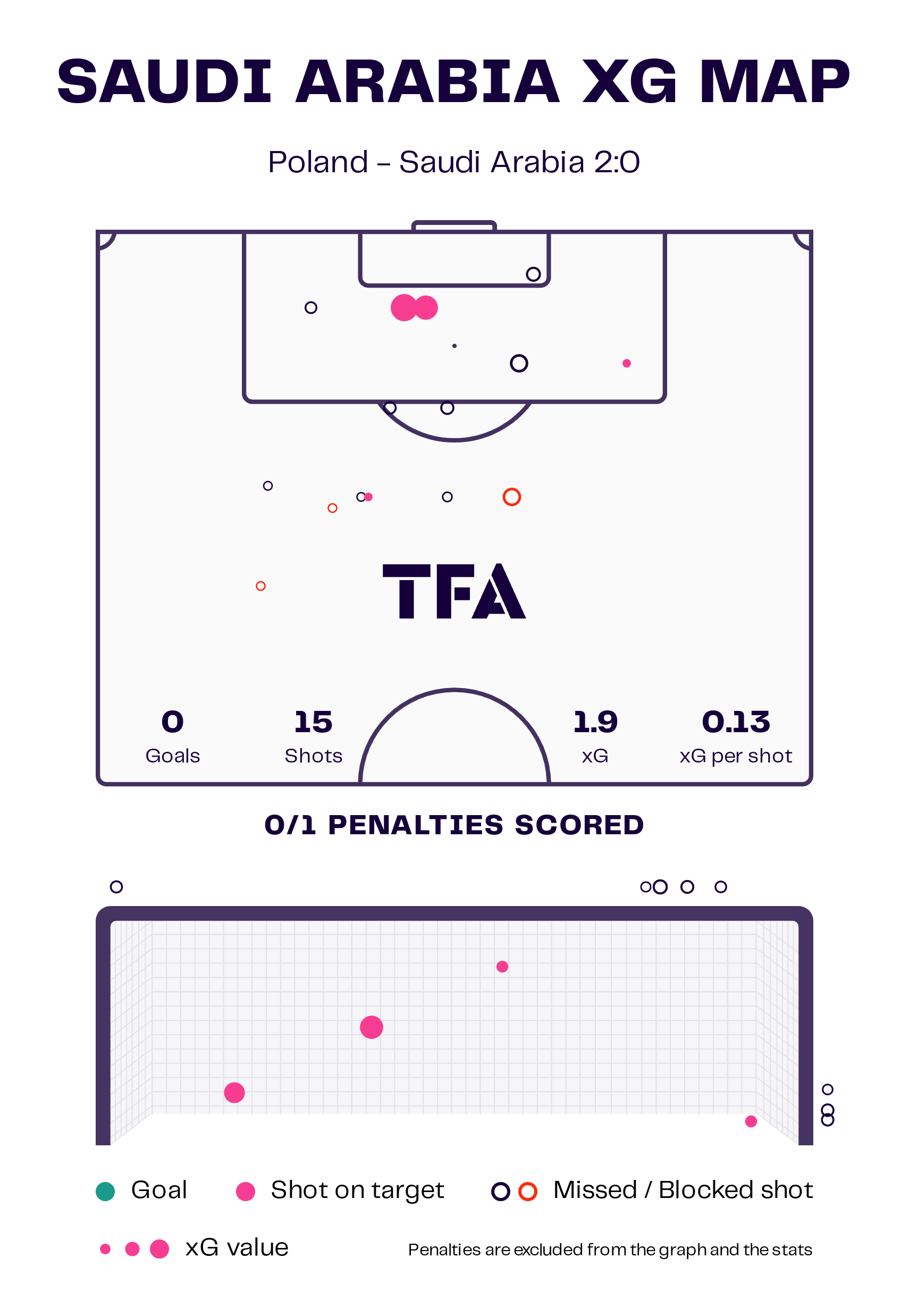
Saudi Arabia ended up generating 15 shots and 1.9 xG versus Poland. While they didn’t actually score, they gave themselves some great chances of doing so — and were ultimately denied brilliantly a couple of times by an on-form Szczęsny.
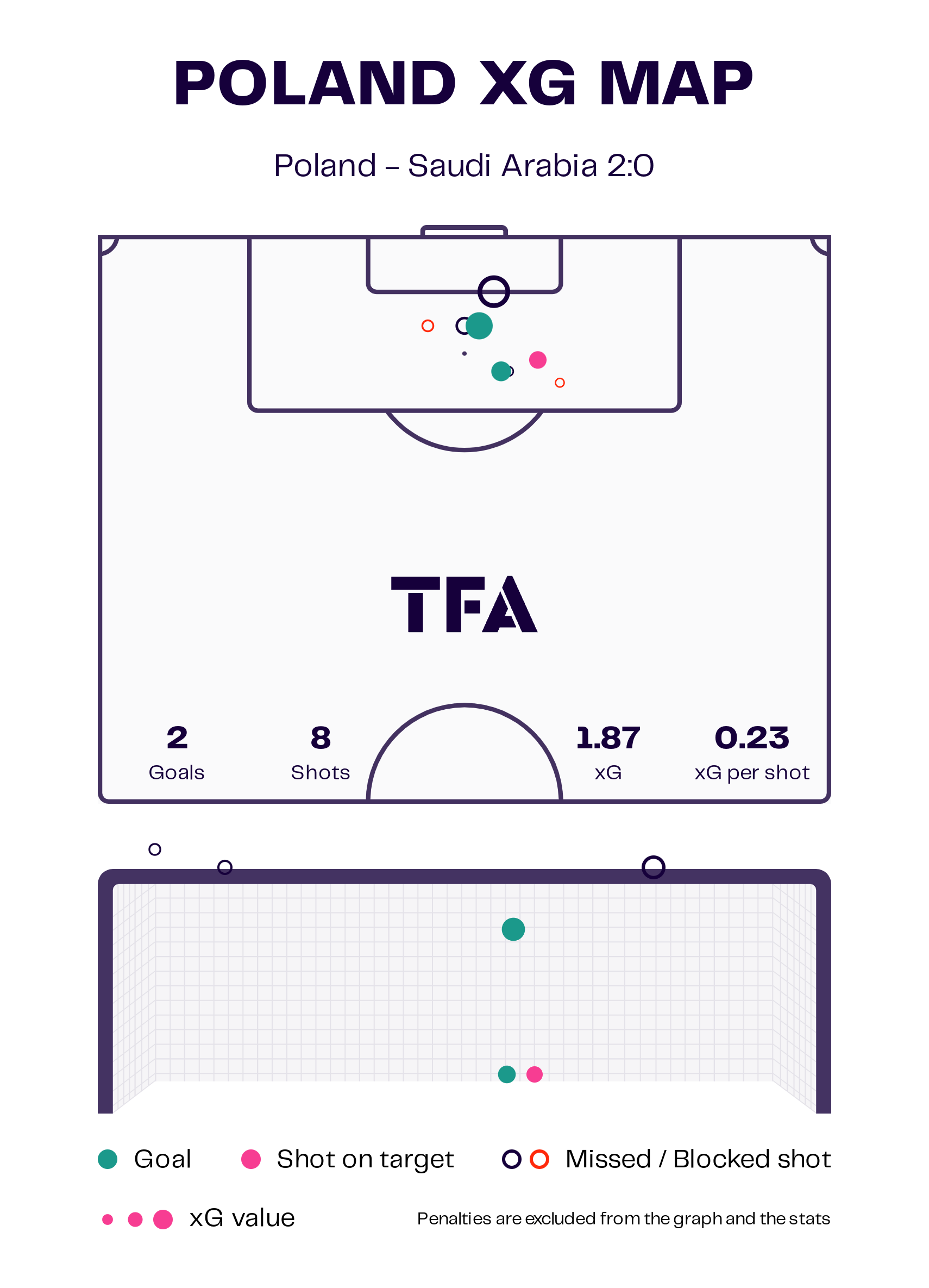
Despite taking just over half as many shots as Saudi Arabia, Poland generated almost the same amount of xG — and scored two goals. What’s worth noting with figures 9 and 10 is the xG per shot number. Saudi Arabia’s is 0.13 and Poland’s is 0.23. The European side gave themselves a far better chance of scoring from the shots they did take on any given shot than the Asian side did.
There could be some valid criticism of Saudi Arabia’s shot selection, as while they created a couple of great, clear-cut chances, a lot of their possession and beautiful build-up was ultimately wasted when an impatient attacker opted to just go for goal from distance rather than continue working the ball into a high-value shooting position. Saudi Arabia should’ve been a bit more patient at times and could’ve generated even more chances from high-quality positions, as they demonstrated the technical quality to break Poland down, even in the European side’s well-organised low block.
Poland, on the other hand, managed to generate good chances on the counter. They were frustrated for long periods of the game and this was evident at times through Robert Lewandowski’s movement.
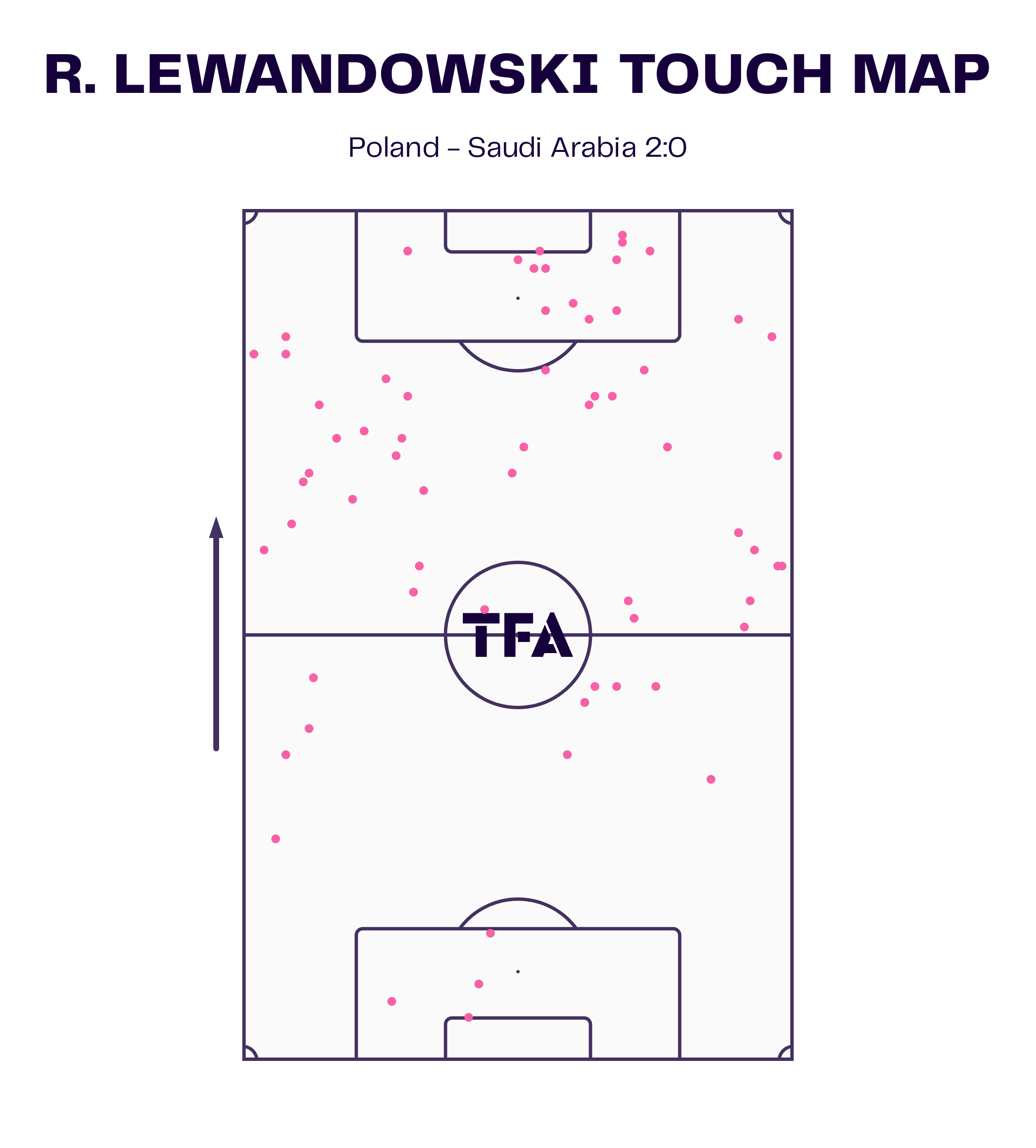
Poland’s star striker was dropping off into deeper and wider positions at times during the game when his team had not been active around the opposition’s penalty box for some time, when ideally he’d be positioned centrally, capitalising on opportunities created by his team.
However, Poland’s attackers weren’t starved for the whole game and their team managed to create some excellent goalscoring opportunities via low cutback crosses after getting in behind Saudi Arabia’s high backline on the counterattack — with both of Poland’s goals coming from such a situation.
Saudi Arabia’s aggressive defending
The final section of our analysis looks at Saudi Arabia’s aggressive defence and how they used their intense pressing as another offensive tool. Firstly, let’s compare Saudi Arabia’s defensive territory with that of Poland to demonstrate a little bit about how the two teams differed significantly in terms of their defensive approach in this game.
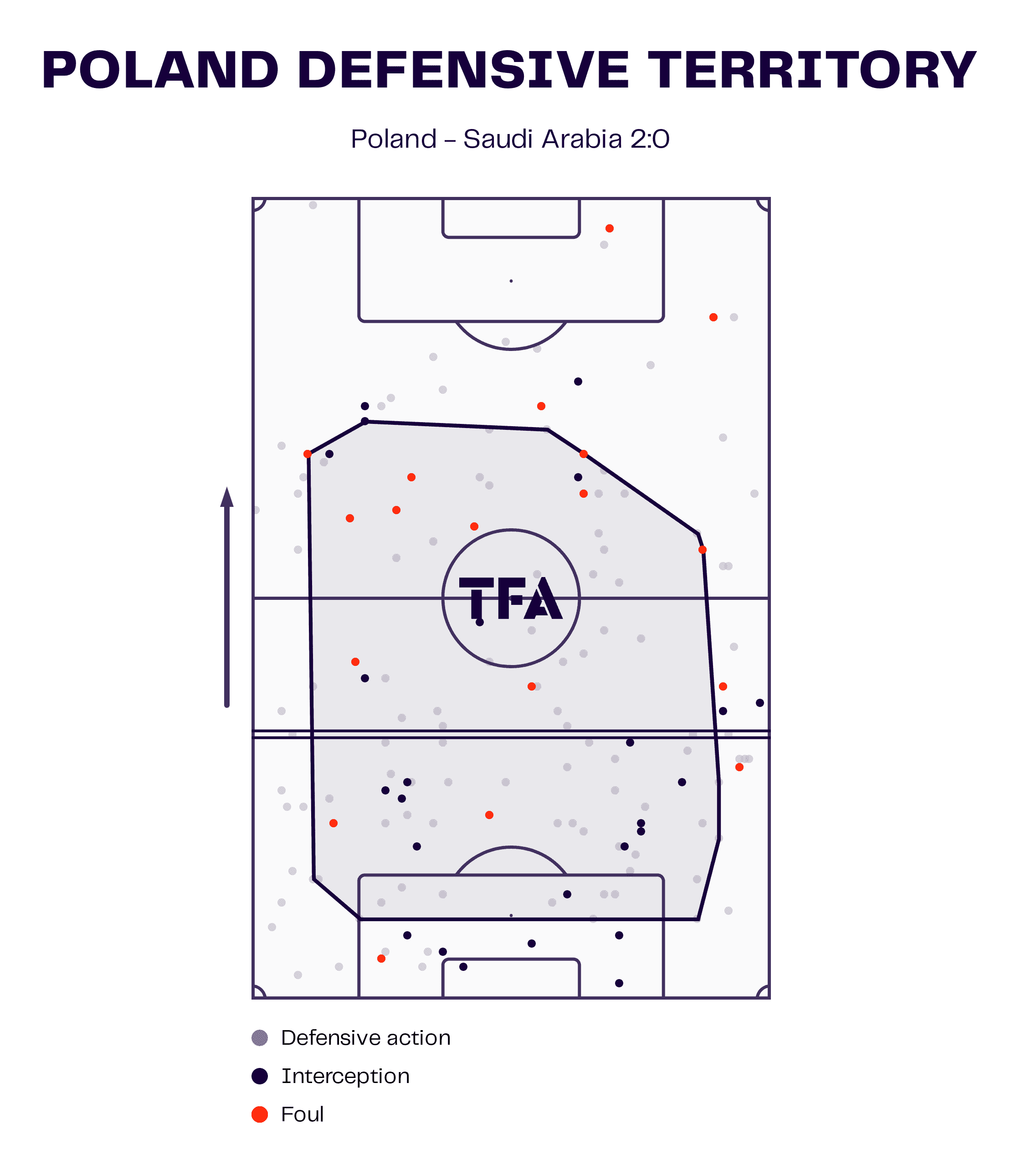
Figure 12 shows Poland’s defensive territory for this game — they were rather reserved and focused primarily on just ensuring they had their box protected, which they largely achieved to a solid extent, as discussed in the previous section of analysis.
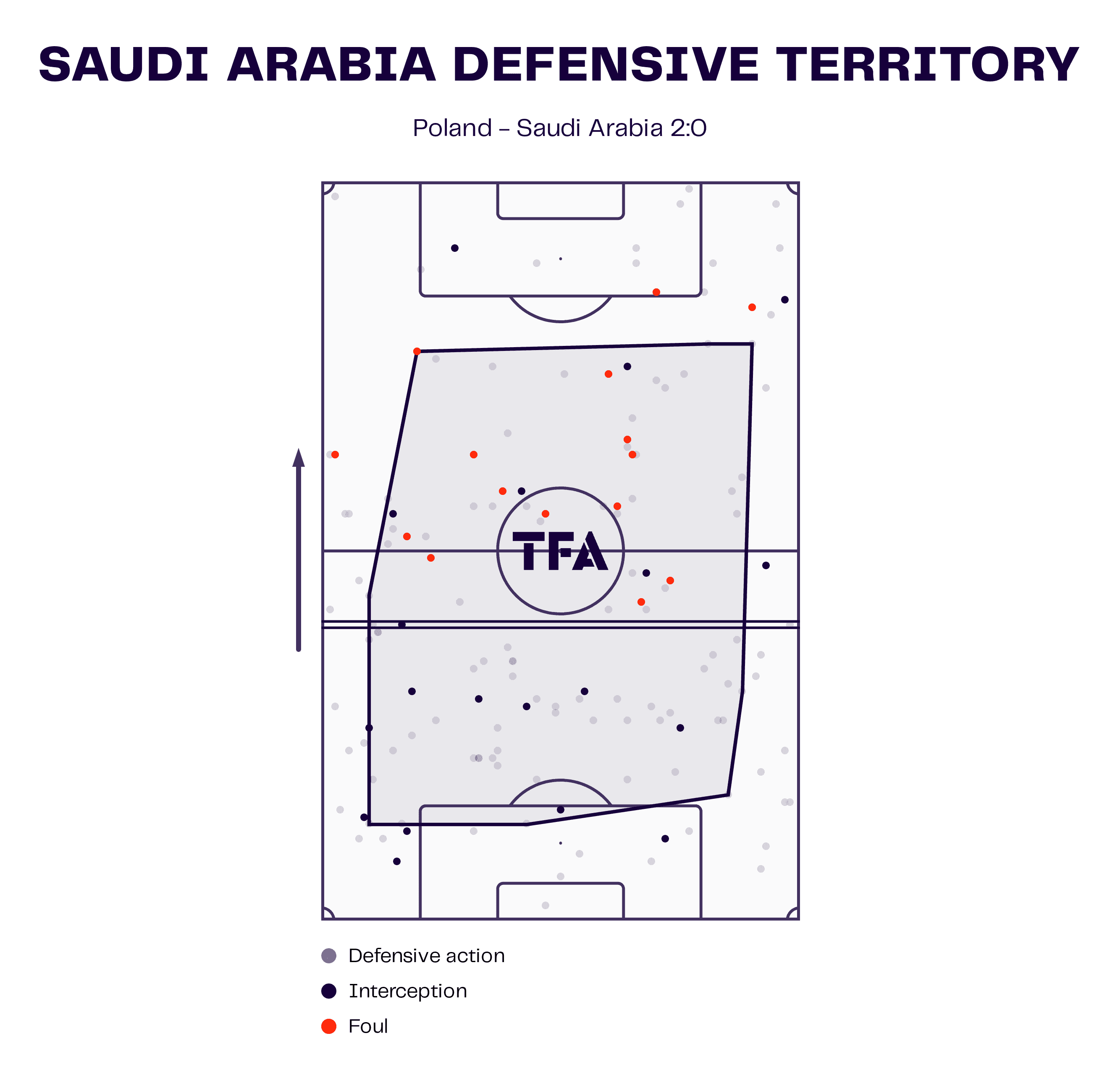
Meanwhile, figure 13 shows Saudi Arabia’s defensive territory. Note how Al-Saqour’s average defensive line is quite a bit higher than Poland’s here, while Saudi Arabia made far fewer defensive actions in and around the penalty area. Defending around here was actually something Renard’s side struggled with a lot in this game. They could deal with balls over the top, they weren’t so much of a problem. However, they struggled to effectively mark the elite attackers at Poland’s disposal, whose movement left the Saudi centre-backs a bit caught in no man’s land at times.
Their struggles with marking Poland’s forwards effectively allowed those players to find a lot of space in high-value positions so they could latch onto those low cutback crosses. The Polish forwards finished their chances far more efficiently than Saudi Arabia’s forwards did. The Polish forwards’ ability to find space in those good positions, along with Saudi Arabia’s struggle to find as much space as frequently in the other box along with the fact that Saudi Arabia snatched at chances a bit, at times, made all the difference.
There were quite a lot of fouls made by both teams in this game, especially when it came to thwarting counterattacks before they progressed to a dangerous point. Both teams committed plenty of tactical fouls around the middle third, as we can see in figures 12-13, and this was largely to contain attempted counterattacks. However, Saudi Arabia were intelligent enough to not foul Poland in the final third, avoiding the chance that they’d give away a free kick or penalty in a dangerous area. Poland didn’t manage to do this, conceding one penalty and a couple of threatening free kicks.
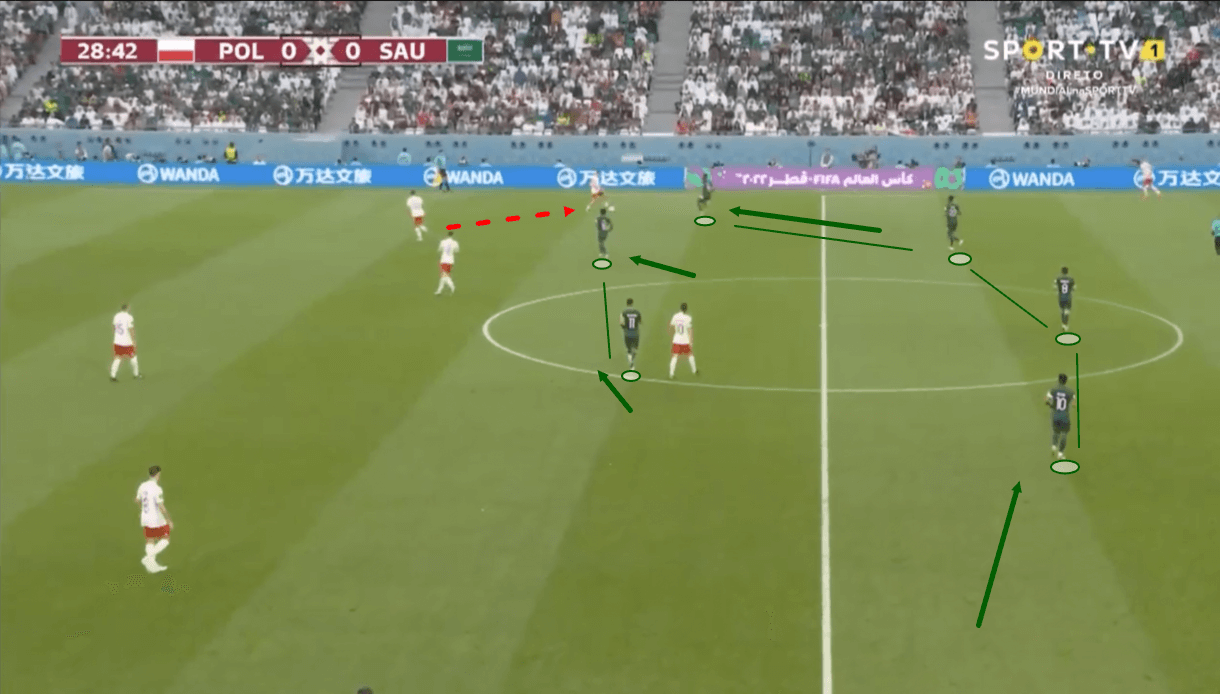
When pressing high in their 4-4-2, the Saudi shape often changed to something more like a 4-3-3, which figure 14 shows. When the ball was played to one wing by Poland, the Saudi winger on that side would step up to close down the full-back. As he did so, the rest of the Saudi midfield shifted over in order to remain somewhat compact and prevent massive gaps from opening just in front of the opposition ball carrier.
The advanced winger had a license to press aggressively when they created this three-man frontline, just as the forwards had a license to press the opposition backline aggressively to try and force errors and create a counterattacking opportunity from high upfield.
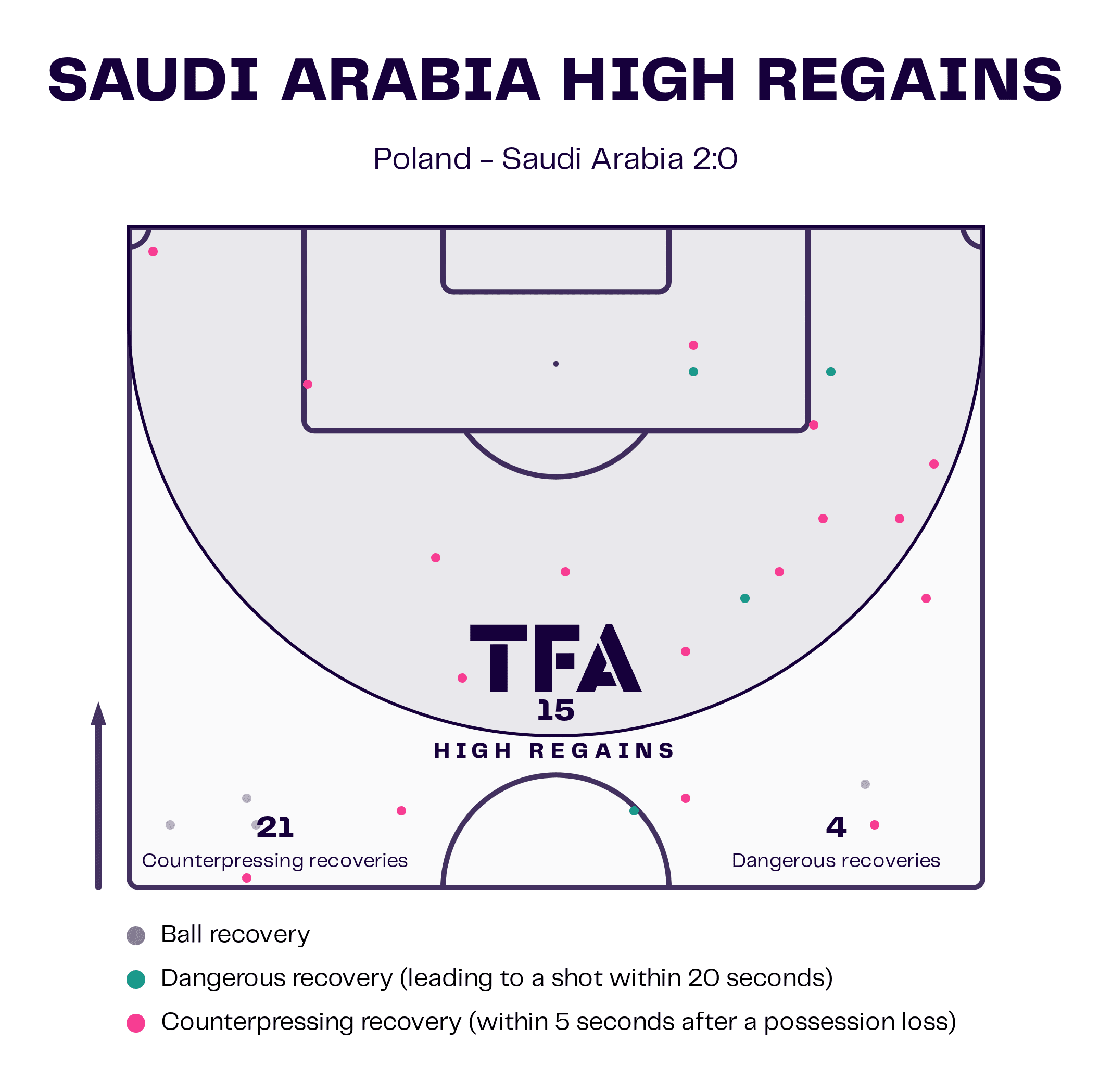
They achieved this on several occasions, making their high press one of Saudi Arabia’s most effective chance creation tools in this game. Additionally, note the 21 counterpressing recoveries that Renard’s side made versus Poland, and you’ll get an idea of why Saudi Arabia dominated the ball so much and Poland were limited to just eight shots at goal.
While Poland set up to counterattack the space behind Saudi Arabia’s high backline here, Al-Saqour did a great job of preventing that from being a possibility very often as they counterpressed aggressively throughout the contest, demonstrating impressive energy and commitment from the first whistle to the last, along with impressive organisation.
Saudi Arabia would typically leave two centre-backs and two midfielders back when attacking upfield and this 2-2 base were able to aggressively confront players on the counterattack, stall their progression and wait for reinforcements to arrive from further upfield.
They usually didn’t have to wait very long, as Saudi Arabia’s attacking players were extremely diligent with tracking back throughout this game and it only ever took them a few seconds to get back and swarm the ball carrier, either regaining possession and starting a counterattack of their own or fouling the Polish player and giving their team a chance to regroup in a more settled defensive shape.
Saudi Arabia’s remarkable off-the-ball effort is a testament to the spirit within their squad and the fantastic job Renard has done in preparing his team to play in this way.
Conclusion
To conclude this tactical analysis, we hope Saudi Arabia’s key tactics in and out of possession that helped them to arguably perform on par with Poland despite ultimately losing the game due to their failure to finish their chances are clear from our analysis of the game. While they lost 2-0, the Saudi side can keep their heads and confidence high heading into their final group stage game versus Mexico.
As for Poland, they didn’t deliver an extremely convincing performance but a solid ability to protect their box for the most part and their clinical nature in front of goal helped them to take three points from this one despite a questionable performance.





Comments